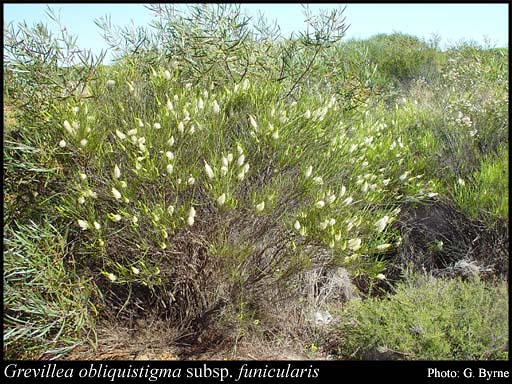- Reference
- Grevillea 1:180 (1994)
- Conservation Code
- Not threatened
- Naturalised Status
- Native to Western Australia
- Name Status
- Current
Spreading shrub, 0.5-2.5 m high. Fl. white-cream, Sep to Oct. Sand, sandy clay over laterite, granitic soils.







Scientific Description
Shrubs, 0.5-2 m high; branchlets glabrous or hairy, with a glaucous bloom or not glaucous. Leaves alternate, 130-160 mm long, 1-2 mm wide, hairy or glabrous, on the abaxial surface, the hairs straight; lamina flat, more or less the same width throughout, entire, the margins revolute, enclosing the lower surface of the leaf blade, forming a groove either side of the midvein. Inflorescences axillary or terminal, white, cream or yellow; pedicels 3-4 mm long. Perianth 3-4 mm long; tepals all free after flower opens, glabrous; ovary glabrous, stipitate, the stipe 1.4-2.5 mm long; pistil 5-7 mm long, white, cream or yellow, pollen presenter oblique, style glabrous. Follicles glabrous, not viscid, dehiscent, 5-15 mm long. Flowers in September, October, November or December. Occurs in the Eremaean (ER) or South-west (SW) Botanical Province(s), in the Yalgoo (YAL), Geraldton Sandplains (GS) or Avon Wheatbelt (AW) IBRA subregion(s).
Distribution
- IBRA Regions
- Avon Wheatbelt, Geraldton Sandplains, Yalgoo.
- IBRA Subregions
- Geraldton Hills, Merredin, Tallering.
- Local Government Areas (LGAs)
- Carnamah, Dalwallinu, Greater Geraldton, Mingenew, Morawa, Mukinbudin, Perenjori, Wongan-Ballidu, Yalgoo.